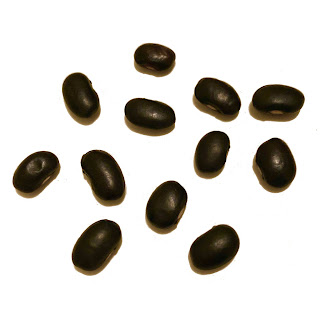black beans
As a kid, when I first tried black beans at a Mexican restaurant after realizing you can order them instead of mushy refried ones, I realized that I actually might like beans. So, because of this fond memory, I’ve decided to start my bean adventure by diving into the culinary world of black beans. However, in contrast to my personal memories, when I started researching black bean recipes, what I found again and again were stories of colonization and war. But before I get into the gory details, which I’ll talk more about in posts about specific recipes, here’s some general history of this meaty little bean.
Black beans, also called turtle beans or black turtle beans, originated in Central and South America over 7,000 years ago, like most common beans [1]. Though most prevalent in Caribbean, Mexican, and South American cuisine, they are now used all over the world. In fact, black beans have the fastest growing demand of all beans on the market [2]. This is perhaps due to their versatility. Because of their small size and sturdy exterior, they hold their shape well when cooked, making them a great ingredient in soups and stews. Their taste and texture also make them one of the best beans to use as a meat alternative. Take it from Karen Cichy, research plant geneticist with the USDA, who commented that “not only are Americans eating more black beans in the traditional boiled or canned form, but black beans are also making their way into many new products such as hummus, crackers and pasta. In 2016, 164 new food products were launched in the U.S. containing black beans and the trend continues in 2017” [2].
We Americans, myself included, may nowadays love our black bean brownies and creamy black bean dips. However, most of us don’t know anything about the history and traditional recipes of our new favorite legume. In my next few posts, I’ll be exploring this bean’s Latin roots. I’ll start in Cuba with the famous "Moros y Cristianos," a delicious take on rice and beans that comes with a story of religious warfare as well. Then, I’ll try Costa Rica’s take on the widely appreciated black bean soup, or "Sopa Negra." Finally, I’ll tell a brutal yet beany story from the Mexican-American War, when black bean seeds made their way to the U.S. with soldiers returning from battle [3]. I’ll accompany the story with a recipe for "Black Bean Burgers." Though not a traditional use, I’m including this recipe to celebrate the integration of black beans into American cuisine, a tiny glimmer of light amidst the darkness and massive death that was the Mexican-American War. It also demonstrates the versatility of these beans and why we have grown to love them all over the world.
[1] Sandborn, Dixie. “Black Beans and Rice History and Fun Facts.” 4-H Plants, Soils & Gardening, Michigan State University, 2 Jan. 2020, www.canr.msu.edu/news/black-beans-and-rice-history-and-fun-facts.
[2]Sandborn, Dixie. “Black Beans and the Science behind Them.” 4-H Plants, Soils & Gardening, Michigan State University, 6 Dec. 2018, www.canr.msu.edu/news/black_beans_and_the_science_behind_them.
[3] Ogden Publications, Inc. “Heirloom Bean Varieties - Organic Gardening.” Mother Earth News, www.motherearthnews.com/organic-gardening/vegetables/heirloom-bean-varieties-zewz1302zsch#Turtle%20Bean%20or%20Turtle%20Soup%20Bean.
Black beans, also called turtle beans or black turtle beans, originated in Central and South America over 7,000 years ago, like most common beans [1]. Though most prevalent in Caribbean, Mexican, and South American cuisine, they are now used all over the world. In fact, black beans have the fastest growing demand of all beans on the market [2]. This is perhaps due to their versatility. Because of their small size and sturdy exterior, they hold their shape well when cooked, making them a great ingredient in soups and stews. Their taste and texture also make them one of the best beans to use as a meat alternative. Take it from Karen Cichy, research plant geneticist with the USDA, who commented that “not only are Americans eating more black beans in the traditional boiled or canned form, but black beans are also making their way into many new products such as hummus, crackers and pasta. In 2016, 164 new food products were launched in the U.S. containing black beans and the trend continues in 2017” [2].
We Americans, myself included, may nowadays love our black bean brownies and creamy black bean dips. However, most of us don’t know anything about the history and traditional recipes of our new favorite legume. In my next few posts, I’ll be exploring this bean’s Latin roots. I’ll start in Cuba with the famous "Moros y Cristianos," a delicious take on rice and beans that comes with a story of religious warfare as well. Then, I’ll try Costa Rica’s take on the widely appreciated black bean soup, or "Sopa Negra." Finally, I’ll tell a brutal yet beany story from the Mexican-American War, when black bean seeds made their way to the U.S. with soldiers returning from battle [3]. I’ll accompany the story with a recipe for "Black Bean Burgers." Though not a traditional use, I’m including this recipe to celebrate the integration of black beans into American cuisine, a tiny glimmer of light amidst the darkness and massive death that was the Mexican-American War. It also demonstrates the versatility of these beans and why we have grown to love them all over the world.
[1] Sandborn, Dixie. “Black Beans and Rice History and Fun Facts.” 4-H Plants, Soils & Gardening, Michigan State University, 2 Jan. 2020, www.canr.msu.edu/news/black-beans-and-rice-history-and-fun-facts.
[2]Sandborn, Dixie. “Black Beans and the Science behind Them.” 4-H Plants, Soils & Gardening, Michigan State University, 6 Dec. 2018, www.canr.msu.edu/news/black_beans_and_the_science_behind_them.
[3] Ogden Publications, Inc. “Heirloom Bean Varieties - Organic Gardening.” Mother Earth News, www.motherearthnews.com/organic-gardening/vegetables/heirloom-bean-varieties-zewz1302zsch#Turtle%20Bean%20or%20Turtle%20Soup%20Bean.


Grand Victoria Casino, Cabazon CA Hotels - Mapyro
ReplyDeleteGrand Victoria Casino, Cabazon CA 사천 출장안마 Hotels The official 남원 출장안마 website of Casino at Grand Victoria Casino. Visit Mapyro for 익산 출장마사지 the 고양 출장안마 complete Las Vegas information 상주 출장샵 and